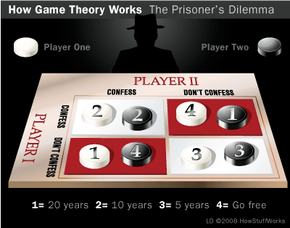The Prisoner's Dilemma
One of the best ways to understand some basic game theory principles is to look at a classic game theory example: the prisoner's dilemma. This game examines how two players interact based on an understanding of motives and strategies. The prisoner's dilemma is a game that concerns two players -- both suspects in a crime. They're arrested and brought to a police station. If both suspects protect each other by staying quiet (called cooperation in game theory terms), the police have only enough evidence to put each in jail for five years.
However, each suspect is offered a deal. If either one confesses (defection from a cooperative relationship), and the other suspect doesn't, the defector will be rewarded with freedom, while the tight-lipped suspect will get 20 years in jail. If both confess, both get 10 years in jail.
Advertisement
It seems both players benefit most by cooperating with each other. Receiving a 20-year jail term is an unacceptable outcome. Since there's an opportunity for one of them to go scot-free by defecting, both players know the other is thinking along these same lines, both must defect out of self-interest. In doing so, the suspects receive 10-year sentences. This isn't the best outcome, but it is the best strategy for the situation the players find themselves in.
Any agreement or heartfelt promise between the two players to cooperate only guarantees that both will, in fact, secretly defect. A mutual promise not to confess actually encourages confession, which leads to freedom (the best individual outcome) for the self-interested.
This is the prisoner's dilemma. Game theorists have determined that confessing is always the answer for both parties in this case. The reason for this is that each party must assume that the other will act with only self-interest in mind.
We can examine the situation by charting it out on a matrix. Matrices allow us to examine all possible strategies and the outcomes that the combinations will produce.
To determine motives, we'll assign a range of preferences to the different outcomes, with 1 representing the worst outcome (20 years' imprisonment) and 4 the best (going free):
- 20 years: 1
- 10 years: 2
- 5 years: 3
- Go free: 4
Now we know our outcomes and preferences, as well as our available strategies: don't confess (cooperation between players) or confess (defection). We can see how different combinations of strategies will create different results. The outcomes are represented by number-pairs, with the first number representing Player 1, and the second number representing the outcome of Player 2.
Now, evaluate your options by examining the outcomes represented in each column. Looking at the first column, we see that 2 is greater than 1, and in the second column, 4 is greater than 3. So, your best strategy, no matter what your partner does, is to defect (confess). Since the outcomes of your confession are better than the outcomes of not confessing, this is called a strictly dominant action.
Why wouldn't a game theorist study solitaire? Keep reading to find out.
